|
|
|
Sort Order |
|
|
|
Items / Page
|
|
|
|
|
|
|
| Srl | Item |
| 1 |
ID:
163160


|
|
|
|
|
| Summary/Abstract |
Frozen conflicts, situations in which war ended yet stable peace did not materialize, trouble both Asia and Europe. Despite the clear policy relevance of this problem, the notion of frozen conflicts remains surprisingly blurred in peace and conflict studies literature. In this paper, we seek to provide a rigorous conceptualization of frozen conflicts. We situate frozen conflicts into a broader debate about enduring rivalries in international politics and demonstrate the theoretical relevance of the term vis-à-vis existing concepts. Furthermore, we outline a theoretical model of frozen conflict dynamics, which portrays frozen conflicts as dynamic configurations undergoing a periodical “thawing” in relations between the opposing sides: either toward diplomatic negotiations (“peaceful thawing”) or re-escalation toward use of armed force (“violent thawing”). We illustrate the usefulness of our model with empirical observations from other articles in this special issue and conclude with possible avenues for further research.
|
|
|
|
|
|
|
|
|
|
|
|
|
|
|
|
| 2 |
ID:
163166
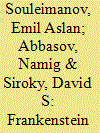

|
|
|
|
|
| Summary/Abstract |
Many scholars have suggested that organized violence in Chechnya has ended, and that Russia’s Chechenization policy and Ramzan Kadyrov’s presidency deserve the credit. We suggest that Putin has created a Frankenstein-like ruler over whom he risks losing control. As a result, the conflict only appears resolved, and we draw attention to both vertical and horizontal cracks in the foundation of Kadyrov’s rule that could lead to renewed violence. Vertically, the Chechen strongman and his growing clout in regional and federal politics have antagonized Russian siloviki. Horizontally, thousands of Chechens appear to be in a state of postponed blood feud toward Kadyrov, his clan, and the kadyrovtsy, his personal army. Backed by President Putin’s personal support, Kadyrov has put in motion a brutal machine of persecution over which some signs indicate he has lost control. Fear of extermination at the hands of the Kadyrov and his personal army has kept most prospective avengers at a bay. Once President Putin’s support wanes, locals will retaliate against Kadyrov and against Russian troops stationed in the republic, and Russian law enforcement circles will openly challenge Kadyrov’s rule. Putin’s support is only likely to wither if the costs of continued support (which grow with Kadyrov’s increasing independence) exceed the benefits (derived from an enforced peace). Either a renewed insurgency or ever more recalcitrant behavior would demonstrate a level of interest misalignment that could induce Putin to withdraw his support. Such a turn of events would render these horizontal and vertical cracks in the foundation of Kadyrov’s rule more noticeable and would likely to cause the frozen conflict in Chechnya to thaw, leading to a new civil war.
|
|
|
|
|
|
|
|
|
|
|
|
|
|
|
|
| 3 |
ID:
163167
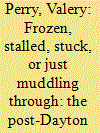

|
|
|
|
|
| Summary/Abstract |
The war in Bosnia and Herzegovina (BiH) ended in 1995, yet the state remains crippled by inertia, escalating political infighting, and domestic and regional rhetoric that undermines efforts at community, social, and political reconciliation. The author argues that BiH can be categorized as a frozen conflict, as the core issues at the heart of the violent conflict of the 1990s have not been resolved. BiH is an interesting case study as the nature of today’s frozen conflict was to a large extent shaped by the very peace agreement that ended the war, which effectively ended the war yet failed to either address the drivers of conflict, or to establish political and structural mechanisms that would help to mediate and govern the country. Following brief historical background, Ludvik and Smetana’s offered subtypes are applied, with various scenarios proposed to illustrate key characteristics. The conclusion argues that no conflict transformation has occurred over the past 20+ years, and the structure of the conflict itself has begun to change over a generation of destructive stasis.
|
|
|
|
|
|
|
|
|
|
|
|
|
|
|
|
| 4 |
ID:
163163
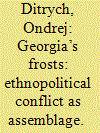

|
|
|
|
|
| Summary/Abstract |
This article is a reinterpretation of ‘frozen conflicts’ as assemblages binding together and strategically orienting a variety of components from both human and nonhuman estates at various scales in order to make a move toward ‘unfreezing’ their research. It then demonstrates how this perspective may be employed in the case of the ethnopolitical conflict in Georgia. The resulting analysis points to several important processes that animate the constant pulsation of the conflict field even when arms are calm and contribute to the dynamic and becoming nature of the conflict and its dynamic (re-)assembling. It illuminates how the visibility function of the assemblage operates and endows with meaning the structure of relations in the conflict field. It traces how the bricolage of Georgian social association transformed over time, notably under Saakashvili, and how it has also been a key element of statebuilding practice in the separatist entities. The analysis moreover demonstrates how the actual instantiations of collective violence form but a fraction of that which takes place in the conflict field, from other forms of political and criminal violence to regime change, state (un-)making through processes of contraction or extension of heterogenous, ‘hybrid’ governscapes including some distinctly virtual ones but betraying real political effects. Finally, it expounds how the ethnopolitical conflict assemblage affixes together a variety of agency from human agents to institutions from local to state governments or the international conflict resolution apparatus in addition to the material (nonhuman) actants enrolled in the translation networks populating the conflict field.
|
|
|
|
|
|
|
|
|
|
|
|
|
|
|
|
| 5 |
ID:
163168


|
|
|
|
|
| Summary/Abstract |
The Kashmir dispute between India and Pakistan remains at the core of one of the most intractable conflicts in modern history. This article provides a plausibility probe into the dynamics of this South Asian rivalry that is conceptually based on the dynamic understanding of “frozen conflicts” introduced in this special issue of Asia Europe Journal. We lay out the key features of the conflict vis-à-vis the redefined notion of frozen conflicts, situating the rivalry in the broader category of unresolved protracted conflicts with a looming threat of violence renewal. In turn, we examine the three transformational dynamics as they operate in this particular case: peaceful thawing, violent thawing, and conflict withering. We conclude that despite the ongoing developments within the conflict dynamics, the possibility of conflict transformation through any of the suggested pathways remains unlikely in the near future.
|
|
|
|
|
|
|
|
|
|
|
|
|
|
|
|
| 6 |
ID:
163164
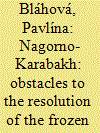

|
|
|
|
|
| Summary/Abstract |
The enduring deadlock in peace negotiations between Armenia and Azerbaijan over Nagorno-Karabakh has created a special, “frozen” phase in the conflict cycle. Several cases of skirmishes, escalating in 2016 during the Four-Day War, demonstrate the security threat the conflict represents. Simultaneously, ongoing unsuccessful peace talks and escalations and de-escalations of violence at the line of contact indicate the failure to transform the conflict in either a peaceful or a violent way. This paper seeks to identify conditions contributing to the stalemate of the conflict. The key actors contributing to the conflict’s “frozenness” are the political leadership of Armenia and Azerbaijan and third parties represented by the Minsk Group. The failure to achieve a peaceful transformation is given by political hostilities carried out through negative labelling, uncompromising statements and the self-victimisation of the belligerents. Such activities deepen the grievances within the Azerbaijani and Armenian populaces, which in response to such behaviour does not support any concessions in negotiations. At the same time, the Minsk Group does not provide any concrete model for a peaceful settlement nor does it apply pressure on the belligerents to grant concessions. A violent transformation of the conflict is not possible due to the presence of third parties in the region which deter the belligerents from full-scale war. These findings indicate that in order to avoid the future failure of negotiations and violent escalations at the line of contact, the political leaderships of Armenia and Azerbaijan need to withdraw from mutual hostilities, the negotiation agenda and framework need to be changed and the third parties involved have to actively participate in the peace process.
|
|
|
|
|
|
|
|
|
|
|
|
|
|
|
|
| 7 |
ID:
163161
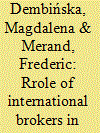

|
|
|
|
|
| Summary/Abstract |
The “frozen” conflict between Moldova and its separatist Transnistrian region—which developed into a de facto state—is dynamic. Despite an active nation-building project to support Transnistria’s independence and a stated willingness to join Russia, Transnistria is juggling between Russia and Europe. While economically dependent on the former’s subsidies and security guarantees, Transnistrian economic ties with the West are growing strong. While most studies are interested in the geopolitical game and the role of external actors, this article argues for a complementary approach that links macro- with meso-level analysis through the role of externally oriented domestic agents. First, the article shows that Transnistria pursues dual alignment in order to survive and provide the population with public goods for which they need external resources. Although Transnistria relies heavily on its patron state, Russia, facing recurrent crisis and external constraints, it has to search for complementary sources of income. Dual alignment is the result of this “multiple asymmetric dependence.” Second, the article argues that local intermingled economic and political interests, embodied by businessmen with close ties not only to Russia but also to Europe, account for how this balancing act is sustained. These informal international brokers or “double agents” mobilize their political connections to support dual alignment while using their Western and Eastern business connections to consolidate their power in Transnistria. It is further argued that the role of international brokers embedded in Russian and European networks and engaging in cross-border cooperation helps understand why the Transnistrian frozen conflict seems to be withering
|
|
|
|
|
|
|
|
|
|
|
|
|
|
|
|
| 8 |
ID:
163162
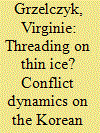

|
|
|
|
|
| Summary/Abstract |
In 2018, both the Republic of Korea (ROK) and the Democratic People’s Republic of Korea (DPRK) will mark the 70th anniversary of the establishment of their separate governments. This is a sad reminder that much remains frozen on the Korean Peninsula. For one, families have been separated and communication channels between the two Korean populations are almost non-existent. Yet, stability is precariously established by an Armistice that was signed in 1953 and that was never replaced by a permanent peace mechanism. Moreover, North Korea’s rapid nuclear development has contributed to tensions and uncertainties, and the Six-Party Talks, originally designed to ensure the denuclearisation of the peninsula, has been at a standstill for almost 10 years. The Korean story is thus a prime case to study the dynamics of a frozen conflict and this article contributes to the existing literature and analysis of frozen conflicts by suggesting looking at peaceful and violent thawing, as well as conflict withering. In order to so, the paper focuses on three crucial levels: (1) the micro level, the impact of the Armistice in light of today’s Koreas as opposed to their status and standing at the end of the Korean War in 1953, (2) the meso level with geostrategic concerns concentrated over sectorial policies surrounding the Korean Peninsula in a globalised world, and (3) the macro level with the changing nature of security governance. It is argued that in a catch-22 motion, the thread of violent thawing maintains the conflict in its frozen state.
|
|
|
|
|
|
|
|
|
|
|
|
|
|
|
|
|
|
|
|
|